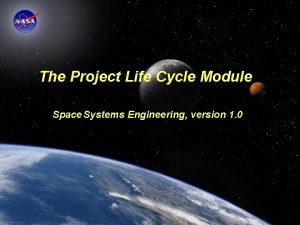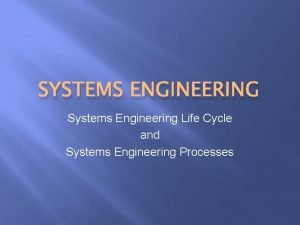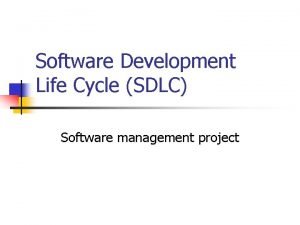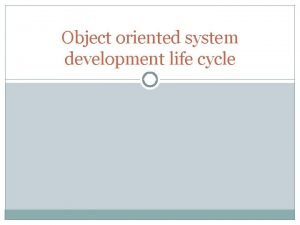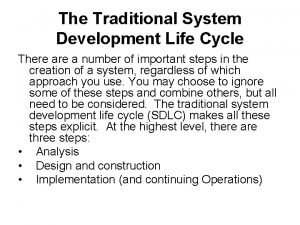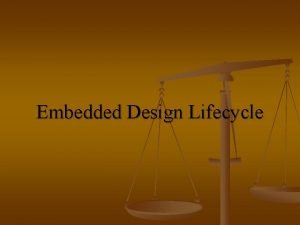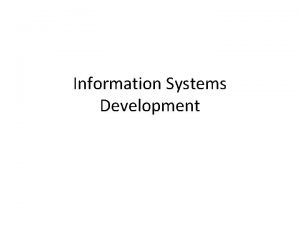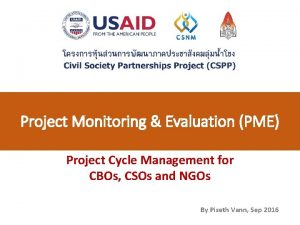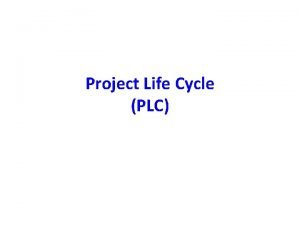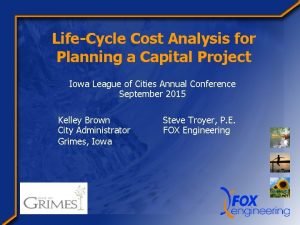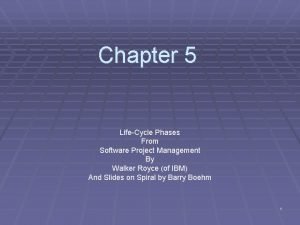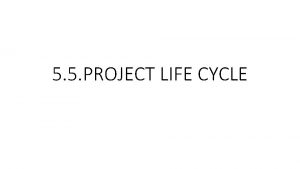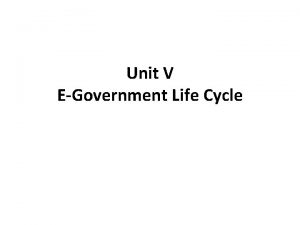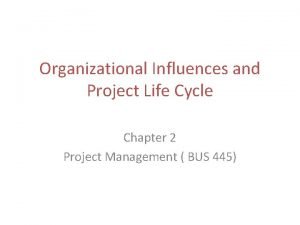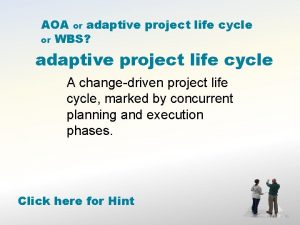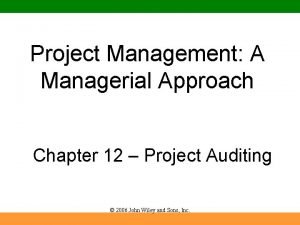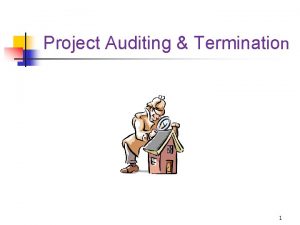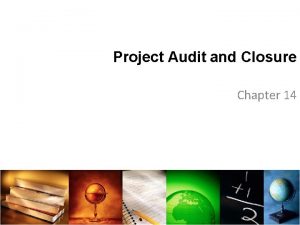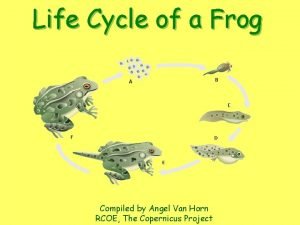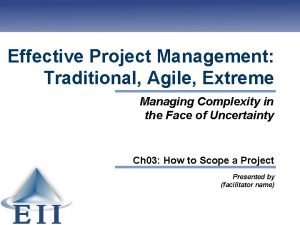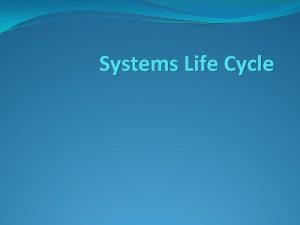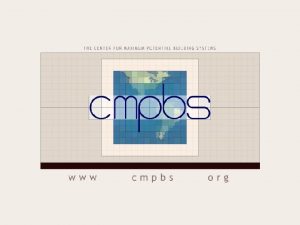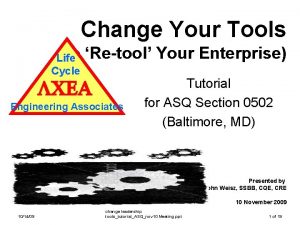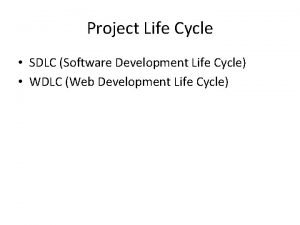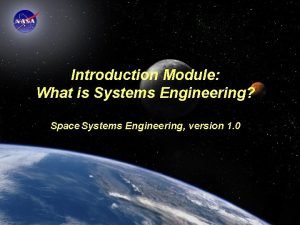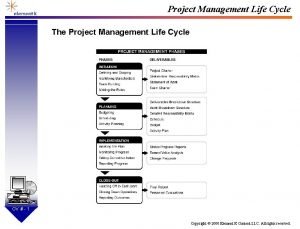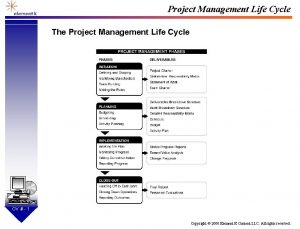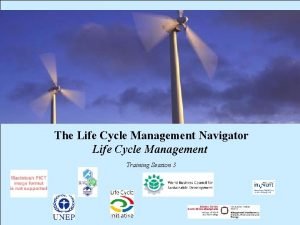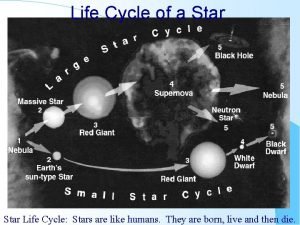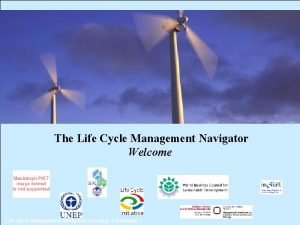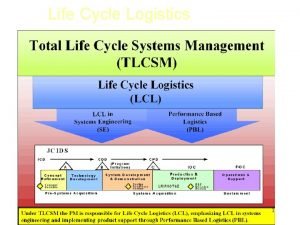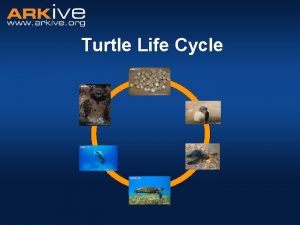The Project Life Cycle Module Space Systems Engineering


























- Slides: 26

The Project Life Cycle Module Space Systems Engineering, version 1. 0 Space Systems Engineering: Project Life Cycle Module

Module Purpose: The Project Life Cycle Describe the common project lifecycle phases, their purpose, activities, products and the review gates that separate them. Define what a system baseline is. Link project life cycle phases to the Vee systems engineering process model. Describe typical development times for each of the NASA project phases. Space Systems Engineering: Project Life Cycle Module 2

Introduction to the Project Life Cycle Lifecycle phases are used to help plan and manage all major aerospace system developments. Everything that should be done to accomplish a project is divided into distinct phases, separated by control gates. • For NASA the phases are lettered: Pre-Phase A, Phase B, Phase C, Phase D, Phase E, Phase F Phase boundaries are defined at natural points for project progress assessment and go/no go decisions. • That is, should a project continue to the next phase, “go back to the drawing board” and redo some current phase work, or be terminated? Decomposing the project into life cycle phases organizes the development process into smaller more manageable pieces. Since early decisions commit later activities and more mature systems are harder to change, systems engineering done in the early phases has the greatest impact on mission success. Space Systems Engineering: Project Life Cycle Module 3

Major Project Reviews Precede Each Key Decision Point FORMULATION A Pre-A Project Phases Key Decision Points Concept Studies IMPLEMENTATION B C D Concept & Preliminary Technology Development Design & Technology Fabrication Completion C B A E F System Operations & Closeout Assembly, Sustainment Test, & Launch Final D E F Mission Concept Review Systems Requirements Review Major Reviews Mission/System Definition Review Preliminary Design Review Critical Design Review Independent Cost Estimates Systems Integration Review Operational Readiness Review Flight Readiness Review Post Launch Assessment Review Decommissioning Review Space Systems Engineering: Project Life Cycle Module 4

Large Projects May Add Subsystem Reviews Before Their Corresponding System Reviews Space Systems Engineering: Project Life Cycle Module 5

Each Milestone Review Creates A New System Baseline A ‘baseline’ is both a noun and a verb. • As a noun it is an agreed-to set of requirements, designs, or documents. • As a verb it is the process of establishing an a baseline. In the context of a system review, a baseline is also defined as a complete system description, including requirements, designs, or documents that will have changes controlled through a formal approval and monitoring, or configuration management process. Since baselines capture the complete system description they are powerful tools in ensuring the entire team is working with the same requirements, designs, constraints, assumptions, interfaces, resource allocations and team responsibilities. Space Systems Engineering: Project Life Cycle Module 6

Project Life Cycle Formulation Phases The project life-cycle phases of formulation and implementation are divided into incremental pieces. This allows the development team to access their progress, estimate system and project performance, plan the next phase and allows decision makers to assess management and technical progress. Formulation • Pre-Phase A (Concept Studies) • Purpose: To produce a broad spectrum of ideas and alternatives for missions from which new projects can be selected. • Define the mission needs, goals & objectives. • Perform studies of a broad range of mission concepts that contribute to goals and objectives. • Develop draft project-level requirements, operations concept, and potential technology needs. • Show that at least one mission concept can work. => Complete Mission Concept Review (MCR): review overall approaches as a baseline for Phase A. Space Systems Engineering: Project Life Cycle Module 7

Project Life Cycle Formulation Phases, cont. Formulation • Phase A (Concept & Technology Development) • Purpose: To determine the feasibility of a suggested new system in preparation for seeking funding. • Define mission success, and minimum mission. • Perform trade studies to compare mission concept options. • Develop a baseline mission concept, including best technical approach, project execution, cost and schedule. • Complete the requirements to the subsystem level. • Identify requirements flow between and across subsystems. • Begin needed technology developments. => Complete System Requirements Review (SRR): Review requirements as baseline for final concept. Establishes the System Requirements baseline. => Complete System Definition Review (SDR/MDR): Review baseline for Phase B. Establishes the Functional baseline. Space Systems Engineering: Project Life Cycle Module 8

Project Life Cycle Formulation Phases, cont. Formulation • Phase B (Preliminary Design & Technology Completion) • Purpose: To define the project in enough detail to establish an initial baseline capable of meeting mission needs. • Refine concept of operations. • Allocate functions and resources (e. g. , mass margins). • Requirements: continue to refine; define flow to the box level; develop verification matrix. • Establish design solution that meets mission needs. • Demonstrate that technology development is complete. => Preliminary Design Review (PDR): Review requirements, design and operations as baseline for detailed design. Establishes the Allocated baseline, also known as the ‘design-to’ baseline. => Non-Advocate Review (NAR)/Confirmation Review: – Do the mission, spacecraft and instrument designs meet the mission/science requirements? – Are management processes sufficient to develop and operate the mission? – Do cost estimates, control processes and schedule indicate that the mission will be ready to launch on time and within budget? Space Systems Engineering: Project Life Cycle Module 9

Project Life Cycle Implementation Phases Implementation (NASA officially commits to the approved integrated baseline) • Phase C (Final Design and Fabrication) • Purpose: To design a system (and its associated subsystems, including its operations systems) so that it will be able to meet its requirements. • Demonstrate that the detailed system design meets requirements. • Demonstrate that the design drawings are complete. • Establishes the product baseline, also known as the ‘build-to’ baseline. • Begin fabrication of test and flight article components, assemblies, and subsystems. => Critical Design Review (CDR): Review design drawings and test plans. Space Systems Engineering: Project Life Cycle Module 10

Project Life Cycle Implementation Phases, cont. Phase D (System Assembly, Integration and Test, and Launch) • Purpose: To build the subsystems (including operations systems) and integrate them to create the system, while developing confidence that it will be able to meet the systems requirements. • • • Perform system assembly, integration, and test. Verify system meets requirements. Prepare system for deployment. Launch system. Verify deployment and operations. => Complete Flight Readiness Review (FRR): review system preparedness for launch. Establishes the ‘As-built’ baseline Mars Global Surveyor during integration and test. Space Systems Engineering: Project Life Cycle Module 11

Project Life Cycle Implementation Phases, cont. Phase E (Operations and Sustainment) • Purpose: To ensure that the certified system is ready for operations. • Implement the Mission Operations Plan developed in earlier phases. • Collect and archive mission and science data. => Complete Post Launch Assessment Review (PLAR): Review to assess readiness to proceed with full, routine operations. Establishes the Operational (or ‘as-deployed’) baseline. Phase F (Closeout) • Purpose: To dispose of the system in a responsible manner. • Conduct a disposal review. • Implement the Systems Decommissioning/ Disposal Plan. • Perform analyses of the returned data and any returned samples. Stardust Landing Space Systems Engineering: Project Life Cycle Module Genesis Landing 12

Project Lifecycles - Incremental Development Phases Captured Via Baselines and Bounded by Technical Reviews Phase A Phase C Phase E Phase D Phase B Flight Readiness Review System Definition Review Functional Baseline Need Specify Post Launch Assessment Review Product Baseline Decompose Design Integrate Verify Space Systems Engineering: Project Life Cycle Module Operational As-Built Baseline Operate Dispose 13

Technical Baseline Definitions System Requirements Baseline (Phase A) • • Functional Baseline (Phase A) • • The product baseline describes detailed form, fit, and function characteristics; the selected functional characteristics designated for production acceptance testing; the production acceptance test requirements. Established at the Critical Design Review (CDR). ‘As-Built’ Baseline (Phase D) • • The allocated baseline extends the top-level performance requirements of the functional baseline to sufficient detail for initiating manufacturing or coding. Established at the Preliminary Design Review (PDR). Product Baseline aka the ‘Build-to’ Baseline (Phase C) • The functional baseline is the approved documentation describing a system’s functional, performance, and interface requirements and the verifications required to demonstrate achievement of those specified characteristics. Established at the System Definition Review (SDR). Allocated Baseline aka the ‘Design-to’ Baseline (Phase B) • The system requirements baseline is the approved system level functional and performance requirements. Established at the System Requirements Review (SRR). The as-built baseline describes the detailed form, fit, and function of the system as it was built. Established at the Flight Readiness Review (FRR). Operational Baseline aka ‘As-Deployed’ Baseline (Phase E) • The as-deployed baseline occurs at the Operational Readiness Review (ORR). At this point, the design is considered to be functional and ready for flight. All changes will have been incorporated into the final documentation. Space Systems Engineering: Project Life Cycle Module 14

The Engineering Activities in the Project Life Cycle Mission Requirements & Priorities Allocate Performance Specs & Build Verification Plan n& e itio nc os ue mp eq co n S De nitio fi De B Design Components Verify Component Performance D Time and Project Maturity Space Systems Engineering: Project Life Cycle Module Subsystems Component Integration & Verification Fabricate, Assemble, Code & Procure Parts C System Level Integrate System & Verify Performance Specs ce Develop System Requirements & System Architecture E Ve In rifi teg ca ra tio n. S n& eq ue n A System Demonstration & Validation Components

NASA Time Scales for Project Life Cycle For a NASA Announcement of Opportunity (AO)-driven mission: • • • The proposing team works Pre-Phase A in 1 st round and Phase A in 2 nd round (if they win). Lots of internal research & development (IRAD) dollars here. Official acceptance puts the mission/proposer into Phase B. Still has to go thru confirmation review to enter Phase C. AO Mission Types • Discovery Program example: • Phase A Concept Study - 7 months • Selection through launch ~ 7 years • Mars Scout Program example: • Phase A Concept Study - 9 months • Selection through launch ~ 6 years • Small Explorer Program example: • Phase A Concept Study - 3 months • Selection through launch ~ 3 -4 years For a facility-class telescope development, 10 -15 years depending on technology development required. For a human spacecraft development (Pre-phase A through Phase D/Launch), on the order of 10 -20+ years. Space Systems Engineering: Project Life Cycle Module 16

Pause and Learn Opportunity Produce in poster format the Defense Acquisition University (DAU) Wall chart - front & back (DAU_wallchart. pdf & DAU_Wallchart. Back. pdf). Display the DAU life cycle wall charts in the classroom. Compare the products, reviews and other aspects of the life cycle with the NASA version in the lecture module. You can also refer to the Johnson Space Center version wall chart (PPF_Wall. Chart_color. pdf) for comparison. Space Systems Engineering: Project Life Cycle Module

Alternatives to the Linear Project Life Cycle The development life cycle is dependent upon the technical nature of what’s being developed => the project life cycle may need to be tailored accordingly. • Alternatives exist in industry and the government. Spiral development, often used in the software industry • Where the development and construction activities proceed in parallel; follows the doctrine of successive refinement. Rapid prototyping • Produces partially operational mock-ups/prototypes early in the design (initiated during preliminary design phase) to allow for learning prior to production of expensive flight unit. Skunkworks (Lockheed trademark) • “A skunkworks is a group of people who, in order to achieve unusual results, work on a project in a way that is outside the usual rules. A skunkworks is often a small team that assumes or is given responsibility for developing something in a short time with minimal management constraints. Typically, a skunkworks has a small number of members in order to reduce communications overhead. A skunkworks is sometimes used to spearhead a product design that thereafter will be developed according to the usual process. ” Space Systems Engineering: Project Life Cycle Module 18

Module Summary: The Project Life Cycle A project is divided into distinct life cycle phases. • • Pre-Phase A: Concept studies Phase A: Concept and technology development Phase B: Preliminary design and technology completion Phase C: Final design and fabrication Phase D: System assembly, test and launch Phase E: Operations and sustainment Phase F: Closeout or disposal These phases are separated by control gates - typically associated with a major project review, such as preliminary design review (PDR). Each project phase has a distinct purpose and set of products. At the end of each phase a new system baseline — or an agreed -to set of requirements, designs, or documents — is established. A system baseline is the point of departure for the development work in each new phase. Space Systems Engineering: Project Life Cycle Module 19

Major Project Reviews Precede Each Key Decision Point FORMULATION A Pre-A Project Phases Key Decision Points Concept Studies IMPLEMENTATION B C D Concept & Preliminary Technology Development Design & Technology Fabrication Completion C B A E F System Operations & Closeout Assembly, Sustainment Test, & Launch Final D E F Mission Concept Review Systems Requirements Review Major Reviews Mission/System Definition Review Preliminary Design Review Critical Design Review Independent Cost Estimates Systems Integration Review Operational Readiness Review Flight Readiness Review Post Launch Assessment Review Decommissioning Review Space Systems Engineering: Project Life Cycle Module 20

Backup Slides for Project Life Cycle Module Space Systems Engineering: Project Life Cycle Module

The Role of SE in the Project Life Cycle Design is a top-down process while the Verification activity is a bottoms-up process. Components will be fabricated and tested prior to the subsystems. Subsystems will be fabricated and tested prior to the completed system. Phase A-B e& System Level Subsystems n sig De ca te, In n& teg rat io nit Item Level Design Requirements FRR Element Fa bri SDR fi De System Level Design Requirements Te st Phase D-E SIR PDR Component CDR Phase C All Design Requirements Complete Space Systems Engineering: Project Life Cycle Module 22

NASA Project Development Times Vary Widely ATP-PDR = Phase A/B; PDR-CDR = Phase C; CDR-Launch = Phase D Space Systems Engineering: Project Life Cycle Module 23

Historical Project Schedule Analysis (months) Example Phase A Phase B Phase C Fab ATLO Total All Inherited Technology MGS 3 3 6 5 9 26 New Engineering Stardust, Genesis 5 7 10 6 12 40 New Technology Cloud. SAT GRACE 6 8 10 9 12 45 Moderately Complex Payload with New Engineering Magellan Odyssey Phoenix 7 7 12 9 15 48 Moderately Complex Payload with New Technology Pathfinder, Deep Impact, MER 8 8 12 12 15 55 Highly Complex Payload with New Engineering Mars Observer 7 7 18 24 22 78 Highly Complex Payload with New Technology Galileo, Cassini, MSL 8 8 18 27 22 81 Space Systems Engineering: Project Life Cycle Module Voyager 24

NASA Project Life Cycle Key Definitions • Formulation: The first part of the NASA management life cycle where system requirements are baselined, feasible concepts are determined, a system definition is baselined for the selected concept(s), and preparation is made for progressing to the Implementation Phase. • Implementation: The part of the NASA management life cycle the detailed design of system products is completed and the products to be deployed are fabricated, assembled, integrated and tested; and the products are deployed to their customers or users for their assigned use or mission. Space Systems Engineering: Project Life Cycle Module 25

The Progression of Requirements Life Cycle Relationships Phase A Concept Studies Concept & Technology Development Phase B Phase C Phase D Preliminary Design & Tech Completion Final Design & Fabrication System Assembly , Int & Test, Launch Phase E Operations & Sustainment Organizations & People Artifacts Problems Concepts Expectations CONOPS System Reqmts. Validation Plan Space Systems Engineering: Project Life Cycle Module Prelim. Design Subsystem Reqmts. Verificat’n Plan Design-to Specs Build-to Specs Verificat’n Procedures As-built As-verified Asdeployed Asoperated Anomalies 26
 Principles of complex systems for systems engineering
Principles of complex systems for systems engineering Engineering elegant systems: theory of systems engineering
Engineering elegant systems: theory of systems engineering Example of fab analysis
Example of fab analysis Systems engineering life cycle
Systems engineering life cycle Sdlc
Sdlc Oosdlc
Oosdlc Traditional system development life cycle
Traditional system development life cycle Embedded design life cycle
Embedded design life cycle Phases of system analysis and design
Phases of system analysis and design Traditional systems development life cycle
Traditional systems development life cycle C device module module 1
C device module module 1 Life cycle of a super large star
Life cycle of a super large star Project monitoring cycle
Project monitoring cycle Programming life cycle (plc)
Programming life cycle (plc) Lcca life cycle cost analysis
Lcca life cycle cost analysis Construction phase in software engineering
Construction phase in software engineering Pre investment phase
Pre investment phase E governance life cycle
E governance life cycle Project life cycle structures
Project life cycle structures Adaptive project life cycle
Adaptive project life cycle In the refrigerator
In the refrigerator Project audit life cycle
Project audit life cycle Define project termination
Define project termination Project audit and closure
Project audit and closure Tadpole angel
Tadpole angel Project life cycle
Project life cycle Diagram of project life cycle
Diagram of project life cycle


